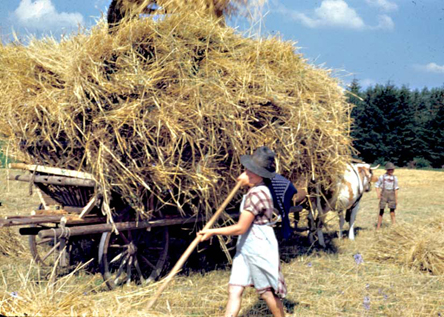By Sgt. John M. Holman, U.S. Army of Occupation, Germany
Hampton Union, 1952
Having indulged in some farming during my life, I was interested to note the difference in methods here in Germany and those back home. From my observations, the soil does not appear as rich as our, and more dry, due perhaps to the fact that much of the practice is hill farming.
In this part of Southern Germany, they seem to know very little about commercial fertilizer and I’ve heard little of organic farming. Their fertilizer comes from animal manure and sewerage which is distributed over the land by means of small tanks on wagons made of either steel or wood. All crops grown on this type of land must be washed thoroughly before being eaten.
The farms themselves are located directly in the small towns with their large barns and barnyards and one and a half story farmhouses. They are so quaint, squatting on their ancient, cement foundations. Some of the barns are kept in good repair, while others are allowed to decay and fall to ruin.
The farmers in Germany are very diligent and energetic workers. From the first streak of daylight in the morning to the last rays of the setting sun, they continually work their crops and tend their livestock.
Farm Outside Town
Though the farm buildings are located in the town, the land they farm is outside the town limits; a situation new and unusual to me.

[Photo courtesy Norman Walker, Hq. & Hq. Co., 1951-1953.]
The machinery used on these farms for planting, cultivating and harvesting the crops is both modern and antiquated. Some of the better paying farms use tractors of a design similar to ones used by our farmers in America, only they are smaller and the models are not as new. Other smaller farms use horses to pull the machinery. Most of the cultivating, however, is done by hand; the wives of the farmers putting in a good day’s work alongside their husbands. And it is not uncommon to see a woman in the field cutting hay with a scythe and loading it onto the horse-drawn wagon.
The vegetables which are grown in Germany are about the same as those in the States, their principal crop being naturally potatoes. The majority of the ones I have seen are much smaller and inferior to our brand. One vegetable they have which we do not is the white radish which is the same size of a turnip and looks like one. The people slice them, put salt on the slices, and eat them with bread and beer. Asparagus is also grown over here, but differently than what we’re used to seeing. When it first comes up out of the ground they cover the stalks with dirt and keep them covered until ready to cut. Then, of course, it is white and stringy when eaten. They wouldn’t think of doing it any other way.
Grain Prevalent
Grain is also prevalent along the rolling countryside, which stretches as far as the eye can see. It is really something to see miles and miles of waving grain. In the fall, at harvest time, one can see the reapers or combines in the fields cutting the grain, tying it in bundles, with men and women walking along behind, stacking the bundles so as to completely dry them out. Some of the less fortunate farmers who do not have combines cut the grain by hand while their wives tie it in bundles, using wisps of grain in lieu of twine. Primitive, but effective.
Livestock such as hens, pigs, cattle, goats and sheep is another common sight on the farm. There are many flocks of sheep all over the countryside, tended by the proverbial sheep dog and shepherd with his staff, such as one read about as a child.
So, in conclusion. let me say that in all, farming matched weed for weed and crop for crop, I’ll take my chances with good old Mother Nature in the good old U.S.A. (That is, if I wasn’t pounding a typewriter for Uncle Sam at the present time). Incidentally, I’m writing this on my off-duty hours. Happy farming!